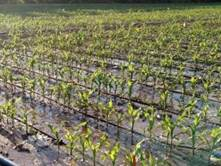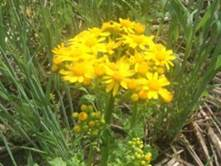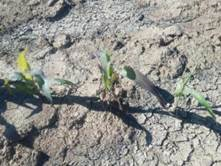Good afternoon,
This week our Hardin County OSU Extension summer intern Dillon Rall and I have been busy doing stand counts in the soybean populations plot and setting traps to monitor insect pests around the county. Insects that we are currently trapping include common armyworm, black cutworm, European corn borer, and spotted wing drosophila. These traps are located around the county where we are monitoring the presence of these pests of wheat, corn, strawberries, blackberries, raspberries, grapes, and peaches. We plan to set up additional types of traps as the season progresses, inform farmers of possible issues, and provide management information if necessary. Since my last newsletter, the crops have really progressed with the exception of some soybeans that have had issues. According to this past week’s Ohio Crop Weather report that I have attached, Ohio is at 97% corn planted and 90% soybeans planted. This is up from a week ago, which had corn at 90% and soybeans at 81% planted (see additional attached report). It appears that only a few soybean fields need to be planted in Hardin County, and possibly some that might be candidates for replanting, at least in spots. May rainfall in the county ended up at 3.40 inches with 4.96 inches for the growing season beginning April 15. To see a township breakdown, check out the attached May 2018 Rainfall Summary.
June 11th Ohio Crop Weather Report
June 4th Ohio Crop Weather Report
There are some local garden programs coming up soon. This Saturday, June 16 there is a program at the Friendship Gardens, 960 W Kohler Street in Kenton about how to design children’s gardens. It is part of a monthly series and will begin at 9:00 am for an hour. All children need to be accompanied by an adult. I have attached a flyer with more information about this series and its location. On June 25 you can learn about gardening with visual, physical or health limitations with Laura Akgerman, Disability Services Coordinator from the Ohio Agrability program. Plan and practice good, safe habits while managing limits and preventing injury. Design your garden to work the best for you, while using adaptive tools to keep your favorite hobby enjoyable. These and other topics will be presented at ‘An Evening Garden Affair’ starting at 6:30 pm with a garden tour followed by the speaker and demonstrations at 7:00 pm. See the attached flyer and news release written by OSU Extension Master Gardener Volunteer Carol McKinley for more information.
Friendship Gardens Workshop Flyer
An Evening Garden Affair Flyer
Evening Garden Affair News Release
On Tuesday, June 26 Peggy Kirk Hall, Assistant Professor and Director, Agricultural & Resource Law Program for OSU Extension will be at the Burnison Barn at the Hardin County Heritage Farm located next to the fairgrounds at 14380 County Road 140 in Kenton. She is going to be discussing the “Five Property Laws that Farmers Need to Know.” Her talk will begin at 7:30 pm and last about 30 minutes with questions. All farmers and property owners are welcome to attend. This program is being provided in cooperation with the Hardin County Farm Bureau and Hardin County OSU Extension. The Farm Bureau is having an ice cream social at 6:30 pm at the site with doors opening at 6:00 pm. Farm Bureau members attending the summer social event are asked to RSVP by contacting the Hardin County Farm Bureau at 419-447-3091 or hardin@ofbf.org. People who are interested in the ag law presentation only do not need to pre-register. More details are in the news release which is attached to this email. I have also included some agronomy articles below that you may be interested in reading.
Mark
Young Corn with Wet Feet: What Can We Expect? – Alexander Lindsey, Peter Thomison, Steve Culman
Around the state, there are many corn fields with young plants with standing water due to the intense storms that have passed through. But what are the long-term effects of standing water on emerged corn? Preliminary data from two locations in Ohio in 2017 suggests that as long as a sidedress N application can be made following the waterlogging, yield loss may be minimal if the waterlogged conditions lasted 4 days or less. Go to https://agcrops.osu.edu/newsletter/corn-newsletter/2018-15/young-corn-wet-feet-what-can-we-expect to read more.
Increasing Variability In Rainfall – Jim Noel
As summer nears, the weather pattern supports an increasing risk of big differences in rainfall totals from too wet to too dry. There is a growing risk of a heat dome developing off the drought area in the south central to southwest parts of the U.S. The heat dome will expand northeast into parts of the corn and soybean belt from time to time over the next several weeks. This means enjoy the cooler than normal weather this week. Storms will ride along the northern edge of the heat dome as it shifts north and south. This means locally heavy rain will be next to areas that get missed. The end result will be a wide variety of rainfall reports in June. Read more about the June weather pattern at https://agcrops.osu.edu/newsletter/corn-newsletter/2018-16/increasing-variability-rainfall.
Weed of the Week: Cressleaf Groundsel – Sarah Noggle
Many questions come into the County Extension Office daily. Many times those include a question about a weed identification. During the month of June 2018, OSU Extension will be featuring a weed identification of the week. This week’s weed is cressleaf groundsel, Senecio glabellus. Cressleaf groundsel is a member of the Aster/Composite family. Cressleaf groundsel can go by many other common names like butterweed, yellowtop, golden ragwort, and yellow ragwort. It can be identified by its small yellow daisy like flowers or its purplish hollow stem and leaves. This plant is commonly found in no-till fields or low till fields. Cressleaf groundsel is highly toxic to livestock and humans. For any additional questions, you may contact your county extension office or go to you your county’s website at your county name.osu.edu for more information. Source: https://cpb-us-w2.wpmucdn.com/u.osu.edu/dist/7/3461/files/2014/04/Cressleaf_groundsel_article_-_p-zna9t9.pdf, https://agcrops.osu.edu/newsletter/corn-newsletter/2018-14/cressleaf-groundsel-wheat-and-hay.
Early Corn Coloration – Green, Purple, or Yellow? – Alexander Lindsey, Steve Culman, Peter Thomison
Corn seedlings often turn yellow (due to low nitrogen uptake and/or limited chlorophyll synthesis) or purple (reduced root development and/or increased anthocyanin production) under cool, wet conditions. Some hybrids are more likely to increase anthocyanin (purple pigment) content when plants are cool. Yellowing or purpling of corn plants at this stage of development generally has little or no effect on later crop performance or yield potential. If it’s induced by environmental conditions, the yellow or purple appearance should change to a healthy green after a few sunny days with temperatures above 70 degrees F. If plants remain yellow, then closer inspection and assessment is needed to determine if yellowing is caused by nutrient deficiency or some other factor. To finish reading this article, go to https://agcrops.osu.edu/newsletter/corn-newsletter/2018-16/early-corn-coloration-%E2%80%93-green-purple-or-yellow.
Agronomic Field Day June 21 at OARDC Northwest Ag Research Station – Alan Sundermeier
The public is invited to attend at no cost the 2018 Agronomic Field Day. It will be held on Thursday, June 21 starting at 9:00 am to 11:30 am. The location is 4240 Range Line Road, Custar, Ohio, 43511.
The topics for the field day include:
•Fertilizer Placement Options for Different Management Systems – John Fulton, Food, Agricultural, and Biological Engineering
•The Impacts of a Half Century of No-Till on Soil Health and Properties – Steve Culman, School of Environment and Natural Resources
•Identifying and Developing Winter Barley Adapted to the Great Lakes, Midwestern and Northeastern State Regions – Eric Stockinger, Horticulture and Crop Science
•Agronomic Management of Winter Malting Barley and Double Crop Soybean – Laura Lindsey, Horticulture and Crop Science
•Management of Seedling Diseases, Wise Choices for Seed Treatments, Potential Herbicide Interactions and Better Cultivar Selection – Anne Dorrance, Plant Pathology
Contact information: Matt Davis, 419-257-2060, or davis.1095@osu.edu
Mark A. Badertscher
Agriculture and Natural Resources Educator
OSU Extension Hardin County
1021 W. Lima Street, Suite 103, Kenton, OH 43326
419-674-2297 Office
hardin.osu.edu




